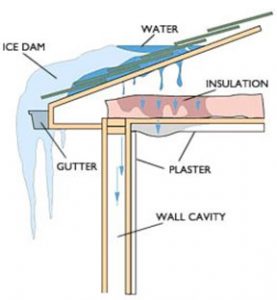
Ice dams are ridges of ice that form along the edges of a roof and block the normal flow of melting snow. When this happens, water can back up behind the dam and leak into the home, causing significant interior damage.
Ice dams typically form under the following conditions:
- Heavy snowfall accumulates on the roof
- Outdoor temperatures remain below freezing for extended periods
- Heat escapes from the interior of the building, causing the snow to melt
- The melted snow re-freezes at colder roof overhangs and gutters, forming a dam
- As this freeze-melt cycle continues, the ice dam grows and eventually forces water to back up under the roofing system and into the structure
In the Greater Cincinnati area, these conditions are common during heavy winter months. Leaks that occur only during snowy, freezing weather—but not during regular rainfall—are often signs of ice dam-related issues.
How to handle?
Ice dam leaks can be managed in several ways, depending on the severity and frequency of the issue:
1. Do Nothing (When Appropriate)
If the leakage was minor and hasn’t occurred before, it may not require immediate attention. Icicles hanging from gutters or downspouts are not necessarily a sign that repairs are needed. If you’re unsure, feel free to email a photo of the ice formation to [office {@} molloyroofing {dot} com], and our team can help assess whether action is necessary.
2. Improve Attic Ventilation or Insulation
Ice dams form when rooftop snow melts—even though outdoor temperatures are below freezing—and then refreezes at the roof edge. This premature melting is typically caused by heat escaping from the home. Proper attic insulation and ventilation help maintain a consistent roof temperature, reducing the risk of ice dams forming in the first place.
3. Install Ice & Water Shield
Ice and Water Shield is a specialized underlayment installed beneath shingles, slate, or tile. It acts as a waterproof barrier and is especially effective in preventing ice dam leakage. This material is most cost-effectively installed during a full roof replacement.
4. Install Roof Heating Cables
In some situations, especially those involving chronic ice damming in shaded or complex roof areas, heating cables may be the only effective solution. These systems typically require a dedicated electrical outlet and must be manually activated when conditions warrant.
Molloy Roofing Company has proudly served Greater Cincinnati for over 125 years. In recent decades, we’ve seen a noticeable increase in ice dam occurrences—likely due to evolving weather patterns and environmental changes. Our team is here to help you assess and implement the right solution for your home.

